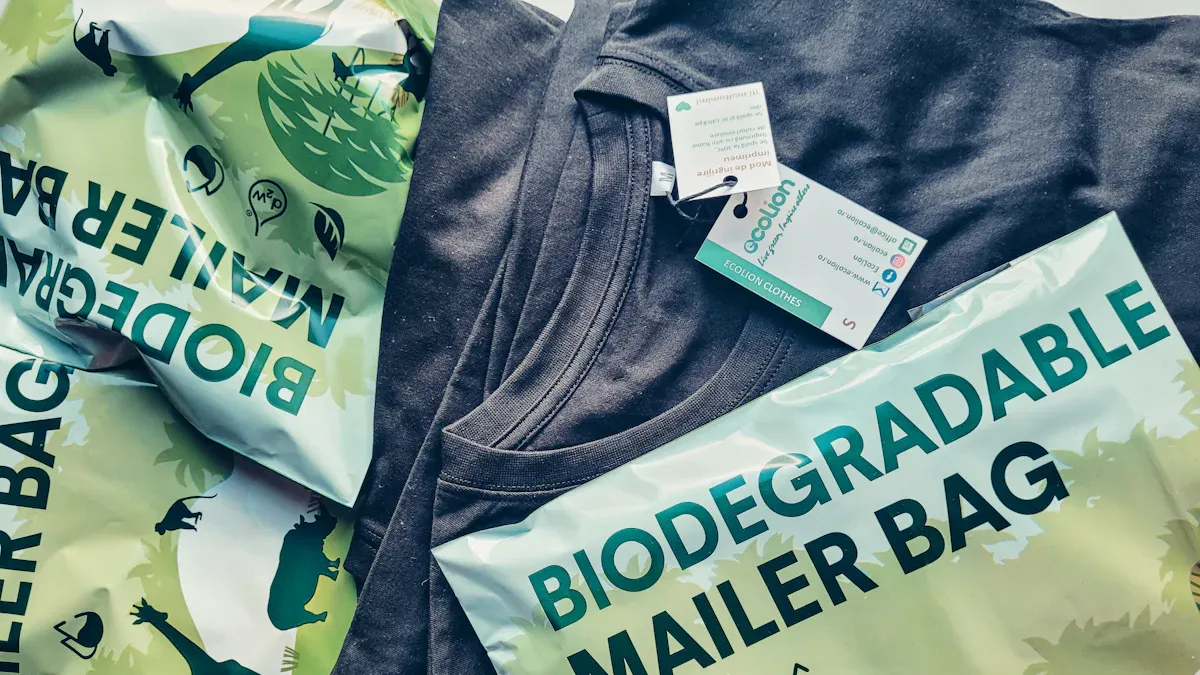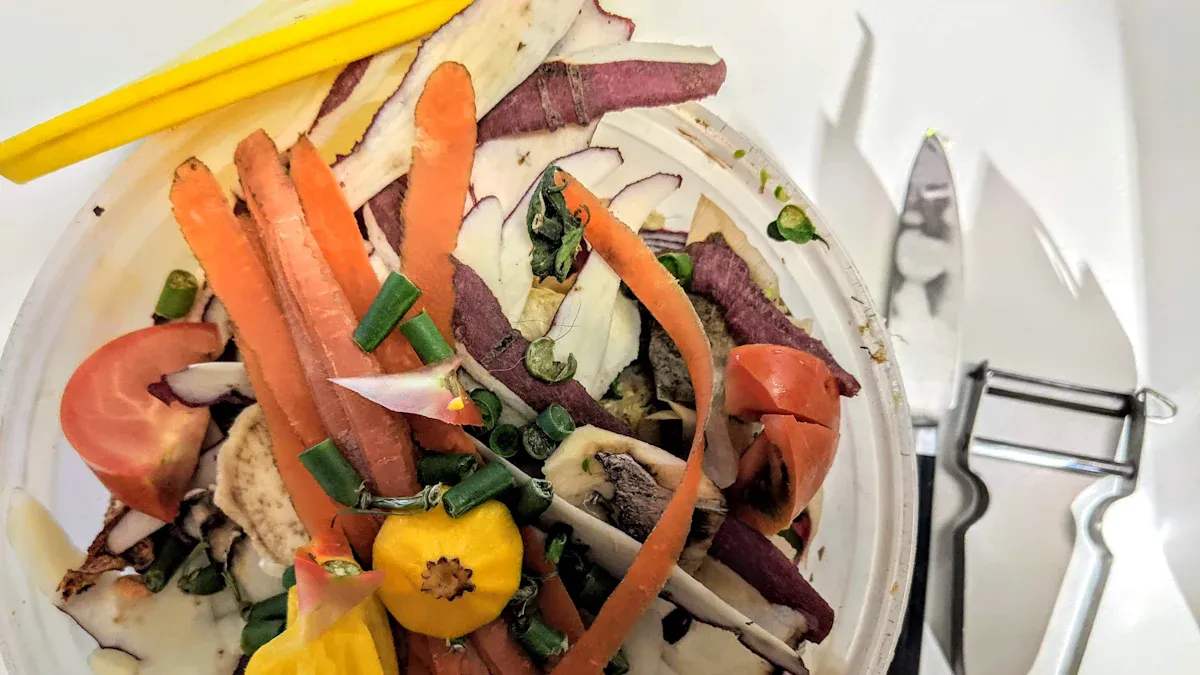You probably notice how quickly trash builds up at home. Many families want to reduce waste and make better choices for the planet. Compostable bags offer a simple way to help. A compost bag breaks down naturally, so you can feel good about what you throw away. Compostable products, like Ecolipak Compostable Trash Bags, give you a cleaner, greener home. These compostable options support your health and the environment. By choosing compostable solutions, you help protect nature and make a positive change every day.
Key Takeaways
Compostable bags break down naturally, reducing plastic waste and supporting a healthier environment.
Using plant-based compostable materials lowers greenhouse gas emissions and promotes sustainability.
Ecolipak compostable trash bags are strong, safe, and designed to decompose in composting systems, making them a reliable choice.
Incorporating compostable packaging into your daily routine helps manage organic waste and enriches your compost.
Choosing compostable over biodegradable products ensures no harmful residues are left behind, benefiting both your home and the planet.
Compost Bag Basics

What Is a Compost Bag
A compost bag is a special type of bag made to break down naturally in composting environments. You use it just like a regular trash bag, but it does not leave behind harmful plastic waste. Instead, it turns into nutrient-rich compost that helps the earth. Many families choose compostable bags because they want to protect the environment and keep their homes healthy.
You will find that most compostable bags use plant-based materials. Here is a table showing the most common materials used:
Material |
Description |
|---|---|
Corn Starch |
A plant-based material used in compostable bags. |
PBAT |
Polybutylene Adipate Terephthalate, a certified compostable material. |
PLA |
Polylactic Acid, derived from renewable resources like cornstarch. |
Starch-based |
Used in creating compostable bioplastics like PLA. |
Plant Material |
Ensures no plastic or toxins are present in compostable trash bags. |
These materials help the compost bag break down quickly and safely. You can feel good knowing you are not adding plastic to landfills.
How Compost Bags Work
When you use a compost bag, you help nature do its job. Compostable bags break down with the help of tiny living things called microorganisms. These microorganisms need oxygen, moisture, and food to work well. When you put your compostable bag in a compost pile or bin, the bag starts to decompose.
Composting is a natural process that turns organic material into soil.
Microorganisms break down the compostable bag into small pieces.
The right mix of temperature, moisture, and air helps the process go faster.
Compostable bags decompose much faster than regular plastic bags. In a composting environment, a compost bag can break down in just 3 to 6 months. Traditional plastic bags can take hundreds or even thousands of years to disappear. By choosing compostable bags, you make a big difference for the planet.
Tip: For best results, always place your compostable bag in a composting bin or facility. This helps it break down quickly and safely.
Compostable Packaging Materials
Choosing the right compostable packaging materials for your home helps you protect the environment and your family's health. You see many options available, each with unique benefits. Understanding these choices makes it easier for you to select the best compostable products for your daily needs.
Plant-Based Options
You find plant-based compostable packaging materials in many products today. These materials come from renewable resources like corn, sugarcane, and other plants. When you use plant-based compostable bags or containers, you support a cleaner planet. These products break down naturally in compost, leaving no harmful residue.
Here are some common plant-based compostable packaging materials you might see:
Sugarcane bagasse
Cornstarch (often used to make PLA bioplastics)
Cellulose molded fiber
Plant-based bioplastics
Plant-based compostable packaging materials have a lower carbon footprint than petroleum-based plastics. When you choose these products, you help reduce greenhouse gas emissions. For example, PLA, a popular bioplastic made from corn, generates nearly 70% less greenhouse gases in landfills compared to traditional plastics. The plants used to make these materials absorb carbon dioxide as they grow, which helps balance emissions.
You can see how plant-based compostable packaging materials compare in market share:
Material Type |
Market Share (%) |
Year |
|---|---|---|
Polylactic Acid (PLA) |
Over 70.0 |
2023 |
Paper and Paperboard |
Largest share |
N/A |
Flexible Packaging |
Largest share |
N/A |
🌱 Tip: When you choose plant-based compostable packaging materials, you support a cycle that helps the earth and your community.
Paper and Cellulose
Paper and cellulose are popular compostable packaging materials for families who want to reduce waste. You see paper used in bags, boxes, and food containers. Cellulose, which comes from plants, is often molded into fiber packaging for cups and trays.
You find these compostable packaging materials in products like:
Paper and corrugated boxes
Recycled paper pulp
Cellulose molded fiber
Paper and cellulose compost easily in home or industrial compost bins. You help keep your home clean and green when you use these materials. However, sourcing cellulose for compostable bags can sometimes lead to environmental challenges. The extraction process may cause deforestation and habitat loss if not managed responsibly. You can look for products made from recycled paper or certified sustainable sources to minimize this impact.
Note: Always check if your paper or cellulose compostable packaging materials come from responsibly managed forests. This helps protect wildlife and natural habitats.
Starch-Based Choices
Starch-based compostable packaging materials offer another eco-friendly option for your home. These materials use starch from plants like corn or cassava. You find starch-based bags, trays, and cushioning materials in stores.
Here are some examples of starch-based compostable packaging materials:
Cornstarch packaging
Bagasse (sugarcane pulp)
Starch-based bioplastics
Starch-based compostable bags break down quickly in compost, making them ideal for dry waste. They cost less and biodegrade rapidly under natural conditions. However, you should know that starch-based bags have limited strength compared to other compostable packaging materials like PLA. They soften or degrade when exposed to moisture, so they work best for dry product packaging and cushioning.
💡 Tip: Use starch-based compostable packaging materials for dry items. For wet or oily foods, choose stronger compostable options like PLA or bagasse.
You help your family and the planet when you choose compostable packaging materials that fit your needs. Each type offers unique benefits for your home and the environment. By learning about these options, you make smarter choices that support a greener lifestyle.
Compostable Trash Bags by Ecolipak
Features and Benefits
You want a cleaner home and a healthier planet. Ecolipak compostable trash bags help you reach both goals. These bags use polylactic acid, a plant-based material that breaks down naturally. You can trust them to hold your kitchen waste without leaking or tearing. They fit standard kitchen bins, including popular models like SimpleHuman, so you do not need to change your routine.
Ecolipak compostable trash bags come in two sizes: 13-gallon and 33-gallon. You get a box with 25 or 100 bags, depending on your needs. Each bag is BPA-free and safe for your family. You can use them for food scraps, paper, and other compostable waste. The bags are easy to tear off and open, making cleanup quick and simple.
Ecolipak cares about safety and quality. The bags hold certifications from trusted organizations. You can see the certifications in the table below:
Certification Body |
Standard Code |
|---|---|
BPI |
US ASTM D6400 |
OK COMPOST |
EN 13432 |
These certifications show that Ecolipak compostable trash bags meet strict standards for compostability and safety. You can feel confident using compostable trash bags in your home.
Tip: Using compostable trash bags helps you reduce plastic waste and support a greener lifestyle.
Durability and Odor Control
You need trash bags that do not break or leak. Ecolipak compostable trash bags have a strong, tear-resistant design. You can fill them with heavy kitchen waste, and they will not rip. The bags handle temperatures from 122°F to 140°F, so you can use them for warm or cold waste.
Odor control matters in every kitchen. Ecolipak compostable trash bags include a natural odor control feature. The bags have a slight corn-like scent from the plant-based materials. This scent helps neutralize unpleasant smells, keeping your kitchen fresh. You can use these bags for food scraps and not worry about bad odors.
Customers trust Ecolipak compostable trash bags for their strength and performance. Recent reviews show high satisfaction:
Total Reviews: 7
5-star Ratings: 100% of reviews
You can rely on these compostable trash bags for daily use. They make waste disposal easier and cleaner for your family.
Environmental Impact
You want to make choices that protect the earth. Using compostable trash bags from Ecolipak helps you lower your environmental impact. These bags break down in home composting systems. In most cases, the bags decompose in about 3 to 6 months. Sometimes, the process takes 180 to 360 days, depending on temperature and microbial activity. In warm conditions, compostable trash bags can decay in as little as 90 days.
When you use compostable trash bags, you keep plastic out of landfills. The bags turn into nutrient-rich compost that helps plants grow. You support a cleaner planet for your family and future generations.
🌎 Note: Using compostable trash bags is a simple step that makes a big difference for the environment.
You can see how easy it is to switch to compostable trash bags. Ecolipak makes it simple for you to protect your home and the planet. Choose compostable trash bags for your kitchen and enjoy a cleaner, greener lifestyle.
Compostable Packaging for Home
Everyday Uses
You can bring compostable packaging into your home in many ways. These eco-friendly alternatives help you manage organic waste and support waste reduction every day. Compostable packaging bags and containers fit right into your kitchen routine. You use them to store leftovers, pack lunches, or line your trash bins. Compostable food packaging works well for serving prepared meals, holding frozen or raw food, and even delivering food to composting facilities.
Here are some common household uses for compostable packaging:
Serving prepared food or storing leftovers
Containing frozen or raw food
Delivering food scraps to a composting facility
Using food-contact packaging and food service ware that is not easily recyclable
Disposing of fiber-based packaging that often becomes food-soiled
You can add compostable packaging to your compost bin along with food waste. This practice enriches your compost with nutrients and supports a greener kitchen. Switching from plastic to compostable solutions, such as compostable food packaging and utensils, reduces the amount of organic waste sent to landfills. You help create nutrient-rich soil for gardening and support sustainable packaging choices at home.
🌱 Tip: Compostable packaging supports eco-friendly living and helps your family make a positive impact on the environment.
Disposal Tips
Proper disposal of compostable packaging ensures you get the most benefit from these eco-friendly alternatives. You should always check if your compostable packaging is labeled for home composting or industrial composting. Home compostable packaging can go straight into your backyard compost pile. Balance your organic waste with greens and browns, and turn the pile regularly for best results.
If you live in an urban area, look for local industrial composting facilities. Many cities accept compostable packaging and compostable food packaging in their green waste programs. Use online directories to find composters near you and verify they accept compostable materials.
Here is a table showing some global guidelines for compostable packaging disposal:
Country/Region |
Policy/Initiative |
Certification/Standard |
|---|---|---|
European Union |
Circular Economy Action Plan |
EN 13432 |
Australia |
National Plastics Plan |
AS 4736 |
South Korea |
Bioplastics Authentication Scheme |
Korean Bio-labelling |
Malaysia |
Draft Guidelines for Bioplastics |
SIRIM ECO 001: 2018 |
Thailand |
National Roadmap for Bioplastic Development |
National Certification |
You support eco-friendly and sustainable packaging practices by following these guidelines. Compostable solutions help you reduce organic waste, promote waste reduction, and protect the planet for future generations.
Compostable vs Biodegradable

Key Differences
You may see compostable and biodegradable packaging in stores and wonder about the difference. Both options aim to support sustainability, but they work in different ways. Compostable bags break down in specific composting environments and turn into helpful fertilizer for the soil. Biodegradable garbage bags can break down in many places, such as landfills or soil, but sometimes leave behind microplastics that harm the environment.
Here is a table to help you compare the two:
Type of Bag |
Decomposition Environment |
Decomposition Time |
Residue Type |
|---|---|---|---|
Compostable Bags |
Composting environment |
90% in 180 days |
Fertilizer, enriches soil |
Biodegradable Bags |
Landfill, soil, compost |
3 to 6 months |
May leave microplastics |
Compostable bags need the right mix of heat, moisture, and microbes to break down. Biodegradable packaging can decompose in more places, but the process is less predictable. Compostable products must meet strict standards to prove they do not leave toxins behind. Biodegradable garbage bags do not always have to meet these rules.
🌱 Tip: Compostable bags are made from renewable resources and help improve soil health. Biodegradable packaging may still release harmful substances.
Which Is Best for Home Use
You want to make the best choice for your family and the planet. Compostable bags offer a more sustainable solution for home use. They break down quickly in compost bins and add nutrients to your garden. Biodegradable garbage bags may seem convenient, but they can leave behind microplastics that harm the environment.
Compostable bags cost a bit more because of their special materials and production. Biodegradable garbage bags are also more expensive than regular plastic bags, but compostable options give you more benefits for environmental sustainability.
Here are some reasons to choose compostable bags for your home:
They support sustainability by turning into safe, nutrient-rich compost.
Compostable bags meet strict safety standards for your health and the environment.
You help reduce waste and promote sustainability in your community.
Compostable bags work well with commercial compostable packaging and home composting systems.
You make a positive impact when you choose compostable products. Your family supports a cleaner, healthier world and sets an example for others. Sustainable choices like compostable bags help protect the environment for future generations.
Choosing compostable bags and packaging helps you protect your home and the planet. You keep harmful plastics out of landfills and support a healthier environment for your family. Ecolipak Compostable Trash Bags make it easy to start this green habit.
Enjoy a cleaner kitchen
Support a greener world
Teach your family about sustainability
🌱 Make the switch today. Share your eco-friendly journey and inspire others to join you!
FAQ
What makes compostable trash bags different from regular plastic bags?
You use compostable trash bags made from natural plant-based materials. These bags break down in a composting ecosystem. Regular plastic bags stay in landfills for years. Compostable bags help you protect the environment and keep your home healthier.
Can I use compostable packaging alternatives for all types of waste?
You can use compostable packaging alternatives for food scraps, paper, and other organic waste. Avoid using them for sharp or chemical items. These bags work best with compostable materials and help you create less trash at home.
How do compostable bags help with reducing single-use plastics?
You choose compostable bags to replace single-use plastics. This choice keeps plastic out of landfills and oceans. You support a cleaner planet and teach your family about making better choices for the environment.
Are compostable bags safe for my family and pets?
You can trust compostable bags. They do not contain harmful chemicals. These bags use safe, plant-based ingredients. You keep your home safe for children and pets while helping the earth.
Do compostable bags break down in home compost bins?
You can add most compostable bags to your home compost bin. Check the label for home composting approval. With the right mix of moisture and air, these bags break down and become part of your garden soil.









